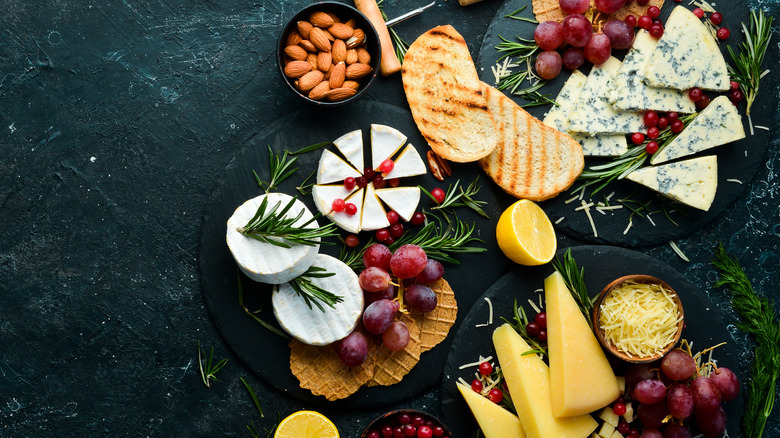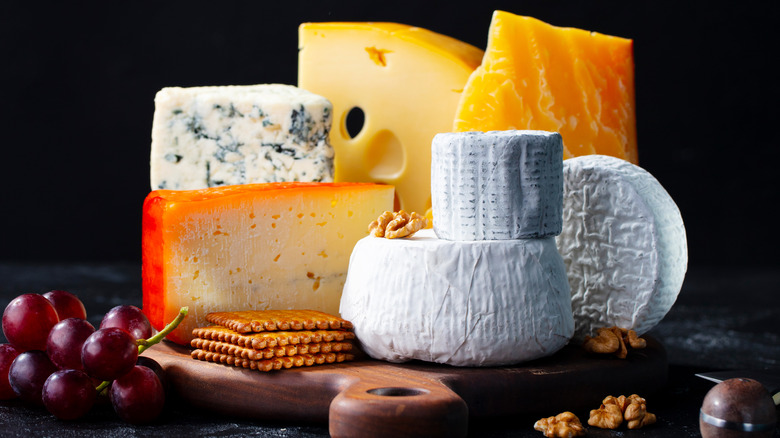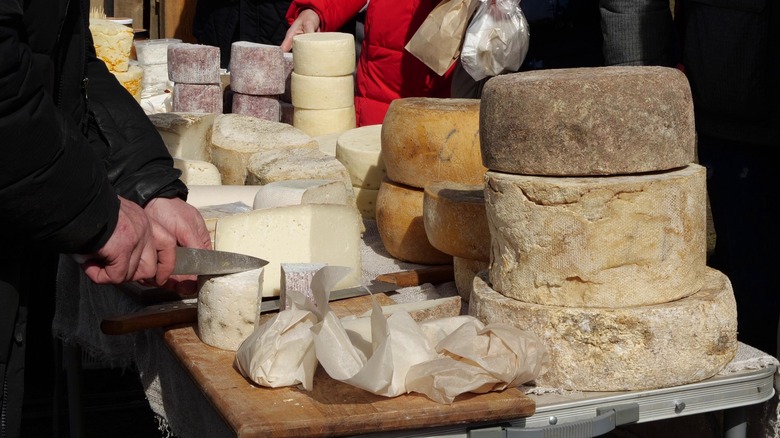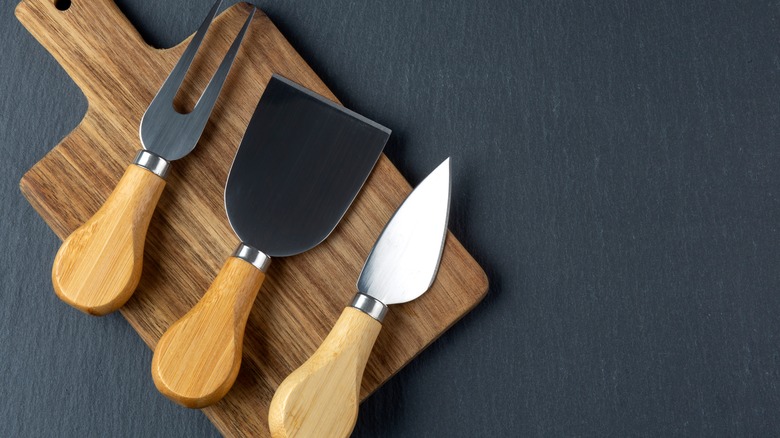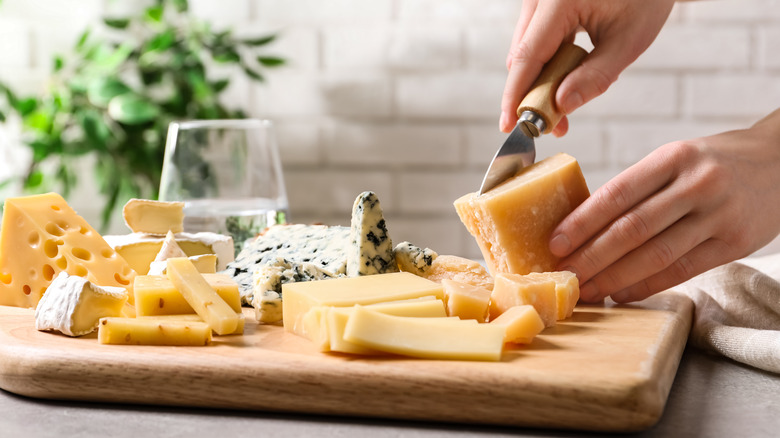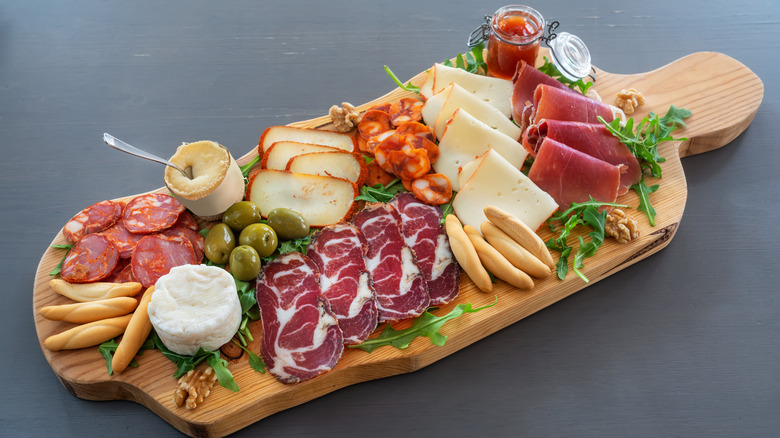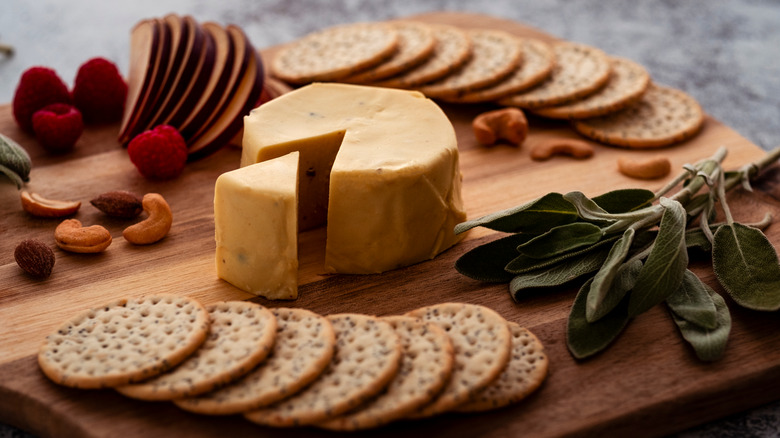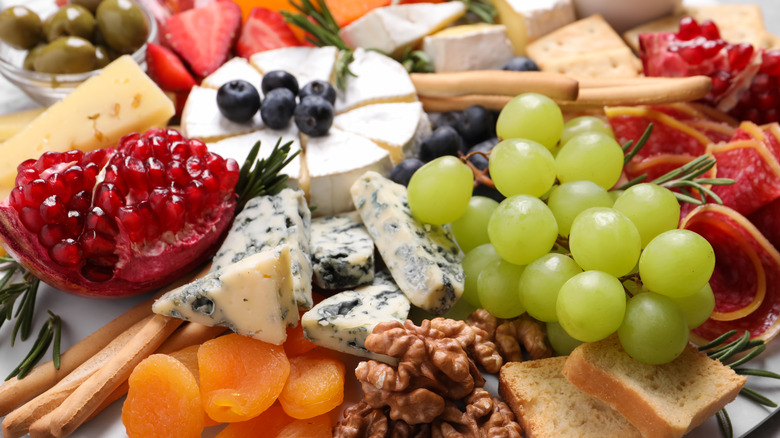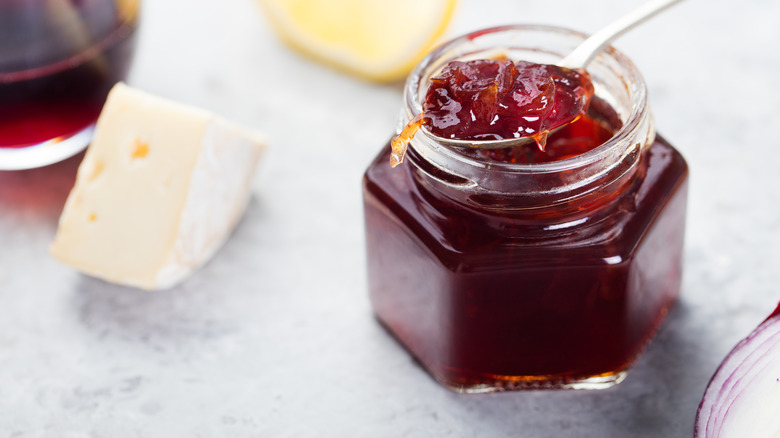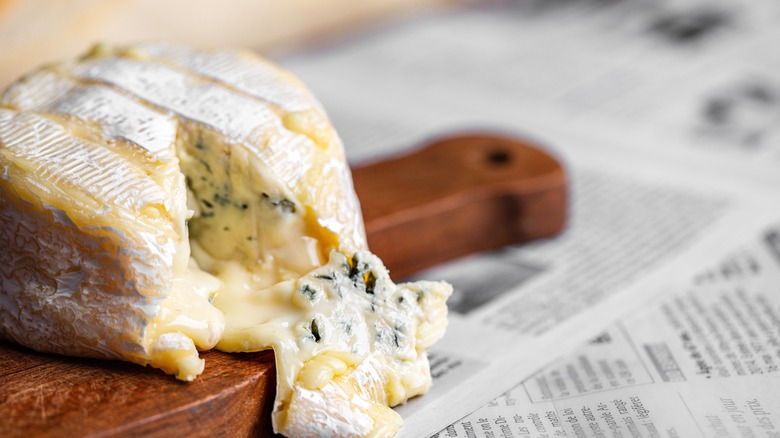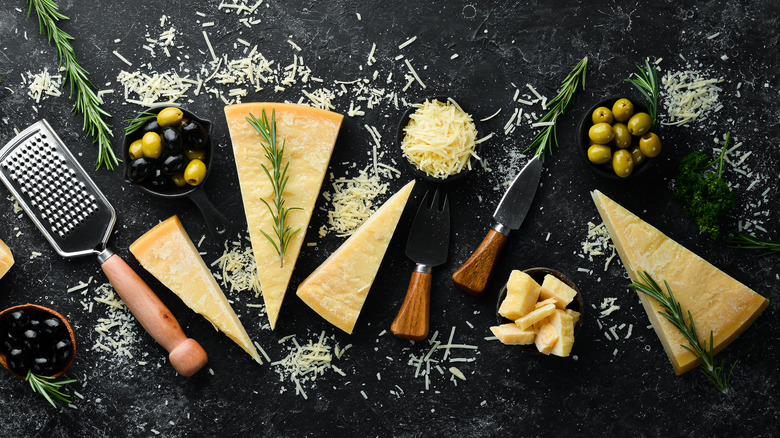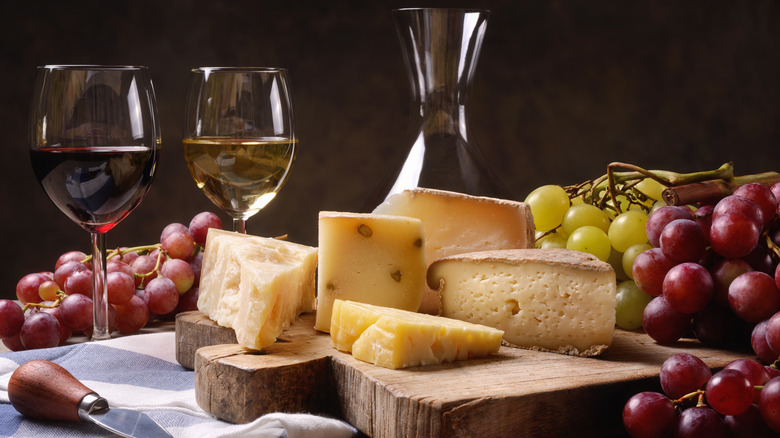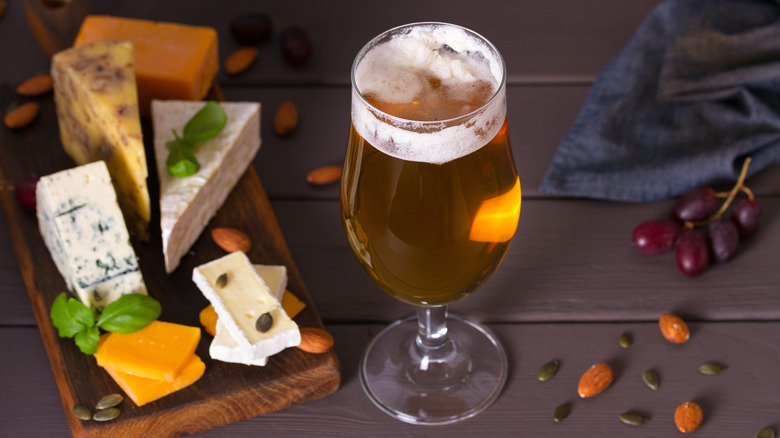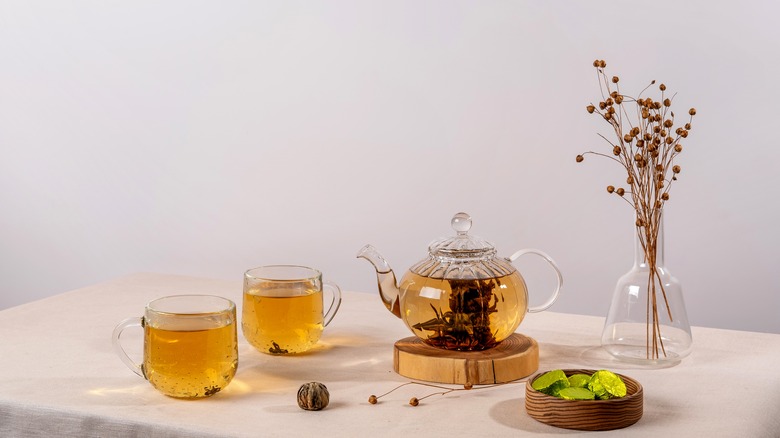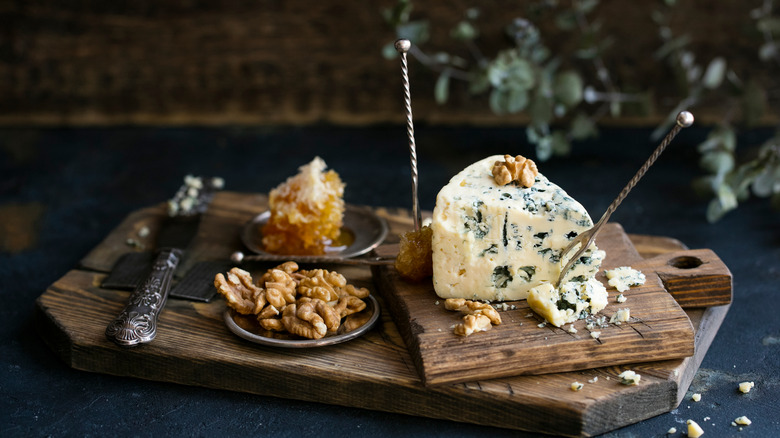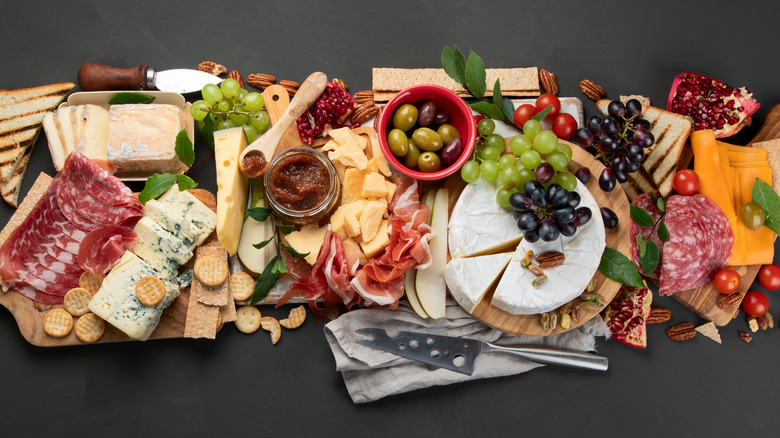Easy Tips For Arranging Better Cheese Boards
Cheese boards have long been a highlight of gastronomic events, from elegant dinner parties to festive family gatherings. In the age of Instagram, the art of arranging beautiful cheese boards has risen to a new level, with amateur enthusiasts demonstrating their flair for creating cheese boards that look as good as they taste.
While placing a few wedges of cheese on a plate is a simple enough task, contemporary cheese boards have become so much more — they can be stunning works of culinary art that combine flavors, textures, and colors into a visual masterpiece.
The secret to crafting the perfect cheese board lies in the delicate balance between the primary components and the ideal accompaniments. Equipped with the right blend of knowledge and creativity, you will take the humble cheese board to artistic and delicious new heights. Join us as we explore 15 easy tips that set your cheese board a cut above the rest.
Serve a variety of cheeses
In your quest to create the perfect cheese board, the first step is to consider the variety of cheeses that you will present. Take the opportunity to showcase a selection of well-loved favorites that will cater to your guests' tastes while also introducing them to a few delightful surprises.
Starting with soft cheeses, brie and camembert are classics for a reason, and your guests won't be disappointed to see them on the board. However, you may wish to serve a young, creamy chevre instead — a mild, spreadable goat's cheese that will provide a tangy option to balance the richer cheeses.
Semi-hard cheeses lie perfectly between creamy and firm and are also an important ingredient in your cheese board. Popular options include nutty Emmental and sharp mature Cheddar, but Manchego can be a great alternative. Since it is made from sheep's cheese, it is a better option for anyone sensitive to lactose. This is a great reason to serve a goat or sheep milk cheese as part of your cheese board.
Hard cheese options include parmesan and aged gouda and have intense flavors to counteract the creamy cheeses you're offering. For a lesser-known option that your guests are bound to love, try Beaufort, an alpine cheese beloved for its fruity and complex flavor.
Lastly, don't shy away from serving a blue cheese on your board. The strong, salty flavor of a crumbly stilton or creamy dolcelatte will complete your cheese board perfectly and give your guests a well-balanced variety of cheeses.
Choose high quality cheeses
Once you have pinpointed which cheeses will make the cut on your cheese board, you should consider where to acquire your cheeses to ensure the best quality. Not all cheese is created equal, and spending time sourcing your cheese can elevate the quality of your board.
Artisanal cheeses — made by hand in a traditional manner — boast a depth of flavor that mass-produced cheese simply cannot match. Each cheese has subtle differences in taste and texture that represent the farm in which it is produced, telling its own story with each bite.
Similarly, opting to purchase cheese from local suppliers will guarantee the freshness of the product and a reduced carbon footprint. By supporting small local businesses, you will contribute to your local economy and sustain jobs in your area.
If you are able to tell your guests about the provenance of the cheese they are eating, it will also create interest and discussion around the cheese board, adding to the engaging atmosphere of the evening.
If budget allows, you should also consider buying organic cheese from grass-fed cattle when available. This means the cows will have been raised in a more natural environment, and the cheese will not be subject to the same toxins as that from conventionally farmed cattle. A study at Harvard University also found that milk from grass-fed cows may lower the risk of heart attacks — meaning organic, grass-fed dairy products are worth paying a little more for (via Reuters).
Use the correct knives
An often overlooked but essential aspect of a cheese board is the choice of knives. As well as improving the aesthetics of your board, the correct knife can make cheese easier to cut and contribute to the overall cheese board experience.
The most important point is to provide a separate knife for each cheese wedge. This reduces the chance of mixing and spoiling of flavors and prevents contamination if any of your guests have food intolerances — though if anyone has an allergy, you should avoid serving that food altogether. Using the correct knives also protects the integrity of the cheeses, preventing them from becoming misshapen and spoiling the look of your beautiful board.
Soft cheese knives have thin blades with holes to prevent the cheese from sticking to the knife. These are ideal for creamy cheeses such as brie and camembert. For incredibly soft cheeses like cream cheese or stracchino, you may wish to use a cheese spreader — a spatula-like knife that allows guests to spread cheese directly onto bread or crackers.
A pronged cheese knife is a great multipurpose option for soft and semi-hard cheeses that allows you to transfer the cheese to a plate using the pronged end. A parmesan knife is the best option for the hard cheeses on your board. Also known as a bell knife, it is designed to cut through both the cheese and the rind, avoiding the issue of your guests trying to saw their way through a stubborn piece of Parmigiano.
Demonstrate cheese cutting
As a good host, of course you want your guests to feel comfortable helping themselves to whatever cheese they want, but you may find that within a few minutes, the beautiful cheese board you spent hours meticulously arranging has become a shadow of its former self. To avoid some of your guests being left with mainly rind and a few unappealing remains of your masterpiece, you should be the first to sample the cheese and set the standard.
If left to their own devices, most people would choose to cut off the 'nose' of a cheese wedge to add to their plate. However, this is considered poor etiquette and should not be encouraged. Instead, demonstrate good form by taking a slice of each cheese before your guests help themselves.
Though virtually all cheese rinds are safe to eat, many find them unappealing in both texture and flavor and may prefer only to eat the body of the cheese. If your guests are faced with a cheese board with more rind than body, it will spoil the overall enjoyment of the event.
Encourage your guests to slice the cheese correctly by being the first to cut into each piece along the length of the wedge, incorporating both the nose and the rind. If your guests follow this example, not only will everyone get an equally balanced taste of the cheese, but your board will continue to look uniform and appealing, even after half of your guests have helped themselves.
Include charcuterie
Unless you are vegetarian, you may wish to add some charcuterie to your cheese board. Smoked and cured meats add wonderful savory notes that will perfectly complement the cheese.
Assuming you want your cheese to be the star of the show, only choose a few meats as an accompaniment — you don't want them to overshadow your cheese. A good mix would incorporate one hard sausage, one soft meat, and one pate or terrine.
Strongly flavored cured meats such as wild boar salami or chorizo pair perfectly with a creamy cheese like brie. Conversely, stronger cheeses can be balanced with milder meats like bresaola or Serrano ham.
When it comes to presentation, you want to make sure the meat is pre-sliced before adding it to your board — you don't want guests trying to slice through a whole salami. Cut hard sausages into thin rounds, then arrange them in strips or circles on the board. Thin, delicate meats like prosciutto can be draped directly on the board or over the other accompaniments, like nuts or fruit. If you want your presentation to impress further, try making "salami roses" out of the soft cured meats — all you need is a shot glass to create a beautiful addition to your board.
If you have any vegetarian guests at your event, do not put meat on your cheese board at any point. If you still want to serve meat, you must make a charcuterie board for meat lovers to choose from.
Crackers and bread
While the star of your cheese board is undoubtedly the stunning cheese selection, you must not underestimate the importance of the crackers and breads that will accompany them. As well as providing a vehicle to get the cheese from plate to mouth, a good selection of crunchy accompaniment options will provide balance and texture, pairing with the cheese to create the perfect gastronomic snack.
A staple of every good cheese board, crackers are a universally loved accompaniment to high-quality cheese. Nowadays, many options exist, including seeded, garlic, olive, or even beetroot. Offer a selection of crackers so that your guests can mix and match with the cheese. Be sure to include at least one gluten-free option and make everyone aware of which one it is.
Alongside your crackers, thinly sliced bread will be another popular addition to your cheese board. If you have time, making homemade bread will wow your guests and allow you to be creative by adding herbs and flavorings that will complement the other items. If you are feeling adventurous, making your own black olive grissini will create a beautiful centerpiece for your cheese board.
In addition to crackers and bread, consider serving walnuts or almonds, assuming you have no guests with allergies. Providing various crunchy and crispy options will ensure everyone has an assortment of textures to elevate the joy and flavor factor.
Add some fresh fruit
Now that you have the backbone of your cheeseboard planned out — the cheese, crackers, and bread — it is time to think about what else will add value to the board and improve the dining experience even further.
Fresh fruit and vegetables can be a great addition to a cheese board, injecting vibrancy and providing balance to the umami flavor of the cheese. Take the opportunity to choose a range of vivid colors to make your presentation even more spectacular.
Crispy apples and juicy grapes are popular matches for cheese, with the acidity cutting through the creaminess of brie or richness of gouda. Sweet fruits, such as figs and pears, also work when they are in season. Pomegranate seeds will look fantastic scattered over the top of your cheese board and provide a satisfying burst of zing.
For vegetables, think raw salad veggies that will provide plenty of crunch and color. Bell peppers, celery sticks, and baby tomatoes will all act as the perfect healthy palate cleanser between cheeses.
In addition to fresh produce, consider pickled vegetables and olives to add another dimension of flavor. Making your own pickled red onion is straightforward and will surpass anything you can buy in the shops.
Fruits and vegetables will perfectly balance the indulgence of the cheese and add a refreshing note to your cheese board. Using seasonal, local produce when possible will ensure your cheese board will look vibrant, and your guests will be delighted by the mouthwatering produce.
Select the best condiments
In addition to the fresh produce on your cheese board, you may wish to offer some perfectly chosen chutneys and jams to complement your cheese. As well as enhancing the visuals of your board even further, these condiments can add an extra layer of flavor and textures to each mouthful.
Sweet, fruity jams work beautifully with most cheeses and especially well with sharp, tangy, or salty cheese. Fig or pear jam will pair nicely with a gorgonzola or aged cheddar. For creamier cheeses, sharp, citrusy flavors will work best. Try cranberry jam to match with brie or even an orange marmalade with a creamy goat's cheese.
Chutney made from vegetables can also be a great addition to your cheese board and provide a savory-sweet element to complement the rich cheeses. A spicy tomato chutney would suit a strong cheese such as parmesan, whereas an onion chutney pairs well with blue cheese. Homemade chutneys are easy to whip up the day before and will keep in the fridge for up to a week.
If you are worried about how you will fit all of your wonderful ingredients onto the cheese board, there is an alternative. According to cheese expert and educator Christine Clark, there is no need to put "messy and/or spreadable condiments like honey, jam, or mustard directly on the board" (via Martha Stewart). If your cheese board is in danger of looking a little crowded, simply present them in miniature jars or bowls straight on the table instead.
Get the temperature right
One aspect of your cheese board that you may have yet to consider is the temperature at which to serve your cheese. It would be reasonable to assume that the cheese should be kept in the fridge until shortly before the gathering to keep it fresh — however, this is not the case. Serving cheese at the appropriate temperature can greatly impact the flavor and texture, so preparing in advance is crucial in providing the best experience for your guests.
Both the aroma and flavor of all cheese will intensify in warmer temperatures, so allowing your cheese time to come to room temperature is essential. Soft cheeses will be too firm if served chilled, so giving them time to reach their perfectly gooey texture is a must. Ideally, all varieties of cheese should be left out of the fridge for at least an hour before they are served, even longer if the room is particularly cold.
If you are serving different platters of cheese throughout the evening, it is worth considering removing them from the fridge in batches, to strike a balance between freshness and optimal temperature.
Leave some space
While squeezing as many varieties of cheese and accompaniments onto your board may be tempting, a truly impressive cheese board will give each cheese some breathing space. As well as being aesthetically pleasing, this can also improve the tasting experience.
When served at room temperature, cheese can take on flavors from other foods and cheeses nearby. In the same way that you shouldn't keep your cheese next to strong-flavored produce in the fridge, leaving space between strong and milder flavors on your cheese board will protect the integrity of each cheese and allow it to retain its unique flavor.
Space between cheeses can also improve the presentation of your board once your guests start to eat. Cutting cheese will lead to crumbling from your firm cheeses and oozing of the creamy ones, so leaving areas for this to happen makes sense. Otherwise, your cheeses will mix together on your board, which is not ideal. It's also easier for your guests to slice the cheese neatly if there is sufficient real estate.
Spreading out your cheeses can also help with the overall elegance — but it doesn't have to mean leaving big gaps on the board. Take the opportunity to fill the spaces with smaller garnishes that won't hinder the cheeses, such as fresh herbs, chopped nuts, or even edible flowers.
Wine pairing
For the ultimate cheese board experience, consider wines that complement the cheeses you are presenting. While fully understanding the intricacies of wine pairing can take years to master, a little research will steer you in the right direction and ensure the wine you serve will balance rather than overpower the heroes of the cheese board.
A famous saying in the wine world — "what grows together, goes together" – is a great place to start when choosing wines for your event. Wine and cheese produced in the same region or country will likely complement each other. Also consider serving both red and white wines, as even the most perfect red wine pairing may not appeal to a white wine drinker.
To keep your white wine drinkers happy, serve a crisp Chardonnay to accompany soft cheeses such as brie, as its acidity will balance the richness of the cheese. A floral Riesling is also an excellent wine that suits hard cheeses such as aged cheddar and gouda.
For the red wine aficionados in your group, a pinot noir is a great option that will match the soft cheese through to the semi-hard, such as Emmental. For a nutty cheese like manchego, a full-bodied red such as Rioja is a perfect match.
Alternative drinks
While cheese and wine are a classic pairing, wine is not the only drink that will fit well with your cheese board. A good host will have a variety of beverages on hand to suit those who are not big grape drinkers, including beer, cider, and non-alcoholic drinks.
As with wine, the key is to serve more than one type of beer or cider to keep flavors balanced. Light, refreshing wheat beers are a great match for mild, creamy cheeses such as cream cheese or chèvre, whereas a darker, malty beer would be a better match for a strong, hard cheese such as gouda. For cider, a dry variety will pair beautifully with tangy goat cheese, while sweeter ciders are the perfect match for a salty blue.
Remember to also cater to your non-drinkers with non-alcoholic wine, beer, and cider, as well as alternative options. Sparkling water is a great option and can act as a palate cleanser, while fresh fruit juices will provide sweet notes to complement the cheeses.
Tea and coffee
While they may not be the first drinks that spring to mind when thinking of cheese, it may surprise you to learn that tea and coffee both complement cheese well and will make an unusual accompaniment to your cheese board. However, you may have to go beyond the usual cup of Tetley if you want to impress your guests!
Tea has a lot more in common with wine than most people think, and similar principles apply when pairing tea with cheese. If a cheese goes well with a wine that is high in tannins, it will also be complemented by a tannin-rich tea. Offer a variety of teas to your guests: Pair a robust black tea with aged hard cheeses or creamy blues, provide a matcha green to complement the fresh and mild cheese, and serve oolong alongside a nutty gouda.
Equally, coffee has a part to play alongside a cheese board, and pairing the right coffee with cheese can be a brilliant match. With coffee and cheese, it is best to keep similar flavors together. A strong, aged cheese will be a great match for a rich, dark roast, while creamy cheeses will work better with a light, fruity coffee.
Introducing tea and coffee alongside your cheese board may be a bold move, but with the right pairings, you can surprise and delight your guests and inspire them to explore new flavor combinations.
Choose the right board material
When presenting your cheese, what you arrange it on is nearly as big a decision as what to serve. There are many classic and modern options to choose from, and some can even affect the flavor of the cheese.
Wood is a classic choice — but avoid using soft woods like oak, as the cheese could pick up flavor from the wood. Opt instead for hard, non-porous woods such as teak or acacia. Bamboo is an excellent alternative to wood, giving you the classic look but easier to maintain. Bamboo is less likely to warp and will not impart flavor to the cheese.
If wood is not modern enough, slate or marble are elegant options. Slate is a non-porous material that is easy to clean, though it may be scratched if your guests use it to cut the cheese. You may wish to precut your cheese to avoid this issue. Marble cheese boards are durable and will keep cheese cool on a hot day, but are heavy and prone to staining in the long term.
Ultimately, your board choice comes down to what features are most important to you. You can even repurpose a board you already use for something else. Patrick McGuigan, food journalist and cheese writer, has used a large butcher's block as a cheese board. "When you put a load of cheese on that it's quite high and almost acts like a podium for the cheese, which looks great" (via Great British Chefs).
Presentation
After all the hard work and research you have put into planning your cheese board, it's now time for the fun part: the presentation! With a few careful touches, you can make sure it looks as good as it tastes.
The first step in arranging your board is to give pride of place to the cheese itself. "When you're composing a cheeseboard, start by placing the whole wedges and large pieces of cheese on the edges of the board," says cheesemonger and writer Carol Penn-Romine. "This way guests don't dredge their knuckles and sleeves through the other items when they're cutting pieces for themselves. Then fill in some of the empty space with complementary items, such as nuts, meats, olives, and fruit" (via Martha Stewart).
You may wish to label the cheeses on your board so that your guests know what they are selecting, and this may also start discussion around certain varieties. If you are arranging your cheeses in order, say from mildest to strongest, let your guests know before they approach the cheese board.
If you have spent time pairing chutneys and accompaniments to specific cheeses, be sure to place them together on the board to maximize your guests' gastronomic experience. Similarly, match up your cheese knives to the appropriate cheese to encourage guests to use the correct one.
Finally, make sure there is plenty of space around the cheese board, allowing your guests to take their time perusing the board without feeling cramped or hurried.

